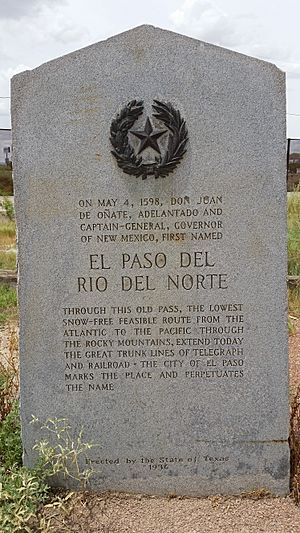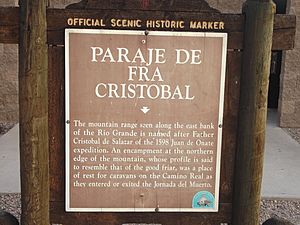Juan de Oñate facts for kids
Quick facts for kids
Juan de Oñate
|
|
|---|---|

Equestrian statue of Juan de Oñate, Alcalde, New Mexico
(Temporarily removed, June 2020) |
|
| 1st Spanish Governor of New Mexico | |
| In office November 1598 – 18 April 1606 |
|
| Succeeded by | Cristóbal de Oñate (son) |
| Personal details | |
| Born | 1550 Pánuco, Viceroyalty of New Spain (now Zacatecas, Mexico) |
| Died | "on or about June 4" 1626 (aged 76) Guadalcanal, Seville, Spain |
| Spouse | Isabel de Tolosa Cortés de Moctezuma |
| Children | 2 |
| Parents | Cristóbal de Oñate Catalina Salazar y de la Cadena |
| Occupation | Explorer and governor of New Mexico |
| Signature |  |
Juan de Oñate y Salazar (1550–1626) was a Spanish explorer and leader from New Spain (which is now Mexico). He became the first colonial governor of the province of Santa Fe de Nuevo México, a region that is now part of the Southwestern United States.
Oñate led early Spanish trips into the Great Plains and the Lower Colorado River Valley. During these journeys, he met many different Native American tribes living in their homelands. He also helped establish Spanish settlements in the new province.
Today, Oñate is mostly known for a terrible event in 1599 called the Acoma Massacre. After a fight where 13 Spanish people were killed by the Ácoma people, including Oñate's nephew, Oñate ordered a harsh punishment. The Ácoma village was destroyed, and many Ácoma people died.
Of the survivors, Oñate ordered that most be forced into "personal servitude" for 20 years. He also ordered that all men over 25 have some of their toes cut off. He was later removed from his position and banned from New Mexico by the Spanish government for using "excessive force" against the Acoma people.
Because of these events, Oñate is a very controversial figure in New Mexican history. In 1998, someone cut off the right foot of a statue of Oñate in Alcalde, New Mexico, as a protest. In 2020, this statue was temporarily removed by local officials.
Contents
Juan de Oñate: Explorer and Governor
Early Life and Family
Juan de Oñate was born in 1550 in Zacatecas, which was then part of New Spain. His father, Cristóbal de Oñate, was a Spanish explorer and a wealthy silver mine owner. His mother, Doña Catalina Salazar y de la Cadena, came from a Spanish family with a long history.
Juan de Oñate married Isabel de Tolosa Cortés de Moctezuma. She was the granddaughter of Hernán Cortés, who conquered the Aztec Empire. She was also the great-granddaughter of Moctezuma Xocoyotzin, the last emperor of the Aztecs.
Leading the New Mexico Expedition
In 1595, the Spanish King Philip II chose Oñate to lead an expedition. His main goals were to explore and settle the new lands of New Kingdom of León y Castilla (now New Mexico). He also aimed to spread Catholicism by setting up new missions.
Oñate is known for founding the Province of Santa Fe de Nuevo México. He served as its first governor from 1598 to 1610. He set up his government in a Pueblo Indian village called Ohkay Owingeh. He renamed it 'San Juan de los Caballeros'.
In March 1598, Oñate's group began their journey. They crossed the Rio Grande river near what is now El Paso. On April 30, 1598, Oñate officially claimed all the land across the river for the Spanish Empire.
His expedition then followed the Rio Grande Valley north into what is now northern New Mexico. Along the way, they met many Pueblo Indian communities. Oñate gave land to the Spanish settlers and allowed them to make Native Americans work for them and pay tribute.
The Acoma Conflict
In October 1598, a fight broke out when some of Oñate's soldiers tried to get food from the Acoma Pueblo. The Ácoma people needed their food to survive the winter. The Ácoma resisted, and 11 Spanish soldiers were killed, including Oñate's nephew.
In January 1599, Oñate saw this as a rebellion. He ordered the Ácoma village to be destroyed. This event is known as the Ácoma Massacre. About 800 to 1,000 Ácoma people died during the attack.
The 500 survivors were put on trial by Oñate. All men and women older than 12 were forced into servitude for 20 years. Also, men older than 25 had some of their toes cut off as punishment. When King Philip II of Spain heard about the massacre and the harsh punishments, Oñate was banned from New Mexico for his cruelty. He later returned to Spain.
Exploring the Great Plains
In 1601, Oñate led a large trip eastward into the Great Plains region. His group included 130 Spanish soldiers, 12 priests, and 130 Native American soldiers and servants. They also had 350 horses and mules. Oñate hoped to find Quivira, a legendary "city of gold."
As they traveled, Oñate's group met Apache people in the Texas Panhandle. They followed the Canadian River into what is now Oklahoma. The land became greener, with more water and different kinds of trees.
Meeting Native Peoples
Oñate's group met a large group of native people he called the Escanjaques. He estimated there were over 5,000 of them living in round houses made of buffalo hides. The Escanjaques were hunters who depended on buffalo for food.
The Escanjaques told Oñate about a large city of their enemies, the Rayado Indians, which was nearby. The Escanjaques wanted the Spanish to help them fight the Rayados. They guided Oñate to a large river, where he saw the tallgrass prairie for the first time. He described the land as very fertile.
Near the river, Oñate's group saw hundreds of Rayados. The Rayados seemed ready for war, but Oñate quickly made peace with them. He liked the Rayados, describing them as "united, peaceful, and settled." Their chief, Caratax, guided Oñate to Etzanoa, a Rayado settlement.
The settlement was empty, as the people had fled. It had about 1,200 houses, which were round, grass-thatched, and surrounded by large storage areas for corn, beans, and squash. Oñate stopped the Escanjaques from looting the town and sent them home.
Oñates group continued for a short distance through populated areas. However, the Spanish soldiers became worried about the large number of Rayados. Oñate decided they needed more soldiers to continue, so he turned his group around to return to New Mexico.
On their way back, the Escanjaques attacked Oñate's group. Oñate described a battle with 1,500 Escanjaques, though this might have been an exaggeration. Many Spanish soldiers were hurt, and many native people were killed. After a long fight, Oñate's group continued their journey.
Oñate and his men arrived back in San Juan de los Caballeros on November 24, 1601.
Journey to the Colorado River
Oñate's last major expedition was to the west, from New Mexico to the lower Colorado River valley. In October 1604, his group of about 36 men set out. They traveled through Zuñi and the Hopi pueblos to reach the Colorado River.
They followed the river to its end in the Gulf of California in January 1605. The main reason for this trip was to find a sea route to supply New Mexico, as the overland journey from New Spain was very difficult.
During this trip, they saw different Native American groups living along the lower Colorado River. They also heard stories about places rich in gold, silver, and pearls, though these were not true.
Later Years and Legacy
In 1606, Oñate was called back to Mexico City to answer for his actions. After planning the founding of Santa Fe, he resigned as governor. He was found guilty of being cruel to both Native Americans and Spanish settlers. He was banished from New Mexico for life and exiled from Mexico City for five years.
Oñate eventually went to Spain. The king appointed him head of all mining inspectors in Spain. He died in Spain in 1626. Some people call him "the Last Conquistador."
Remembering Oñate Today
Today, Oñate is seen in different ways. Some honor him as an important explorer. Others criticize him strongly for his cruelty, especially towards the Keres people of Acoma Pueblo.
In New Mexico, some places are named after him, like Oñate High School in Las Cruces, New Mexico. A street in Española, New Mexico, is also named Paseo de Oñate.
Statues and Controversy
There are statues dedicated to Oñate, and they have caused a lot of debate. In Alcalde, New Mexico, there is a bronze statue of Oñate from 1991. In 1998, New Mexico celebrated 400 years since his arrival. Just before this, someone cut off the statue's right foot and left a note saying, "Fair is fair." This was a protest against the foot-amputating punishment Oñate ordered at Ácoma. The foot was replaced, but a line is still visible.
In 2017, the statue's left foot was painted red, and the words "Remember 1680" (the year of the Pueblo revolt) were written on its base. In June 2020, the county temporarily removed the statue to protect it from damage. The future of the statue is still being discussed.
In El Paso, Texas, a very large equestrian statue of Oñate was built in 2006. It is one of the tallest statues in the United States. This statue also caused protests, especially from the Ácoma tribe, because of Oñate's actions. To try and reduce the controversy, the statue was renamed "The Equestrian." However, it was still vandalized in June 2020.
In 2014, New Mexico marked 400 years since Oñate was exiled. He was exiled for poor leadership and extreme cruelty, especially at the Acoma massacre. Despite the terrible things he did, Oñate is still celebrated by some groups today.
Images for kids
-
Oñate's 1605 "signature graffiti" on Inscription Rock, in El Morro National Monument
See also
 In Spanish: Juan de Oñate para niños
In Spanish: Juan de Oñate para niños




